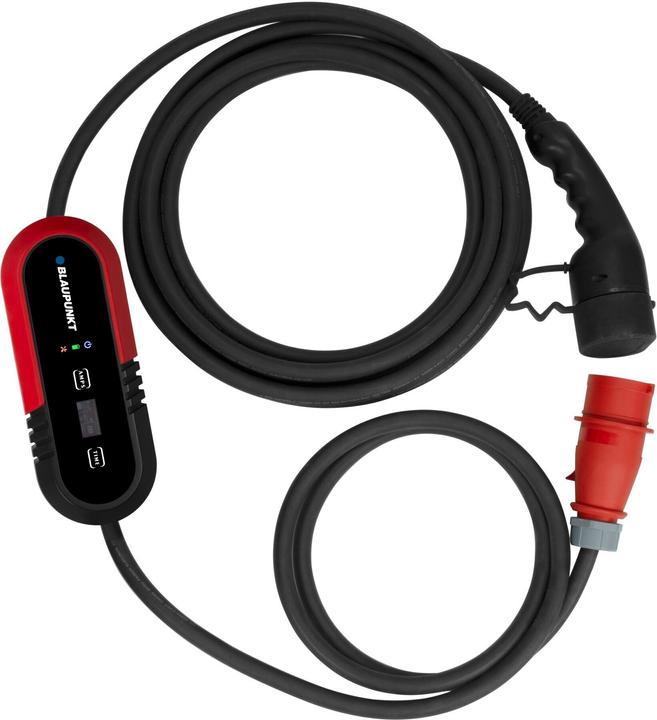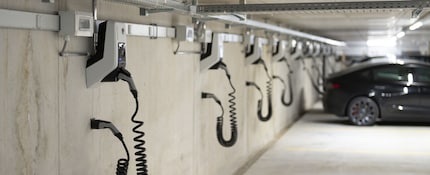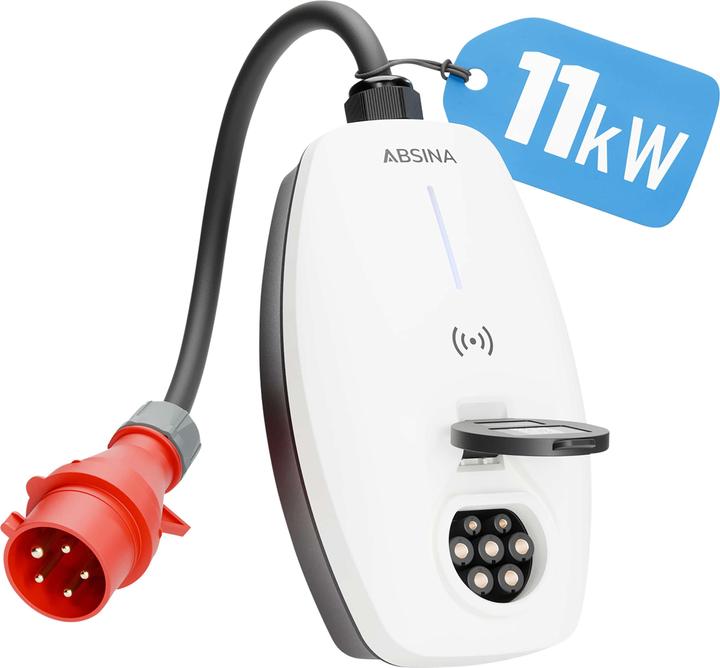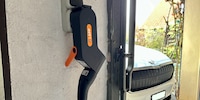

Flexibility is key: mobile chargers are becoming increasingly popular
Anyone who drives an electric car will quickly forget about petrol prices at service stations. Nevertheless, getting around this way isn’t free, and requires an investment in your own charging infrastructure. The trend here is apparently towards mobile charging solutions.
In our range, the best-selling product in the E-mobility section is a so-called mobile charging station. Really, it’s nothing more than a charging cable with a transformer attached.

Indeed, this extended charging cable boasts quite a few advantages. You can set the rated current, enabling up to eleven kilowatts of charging power. Many customers will also appreciate the option of delaying when a charging process starts. This can save you money if electricity costs are cheaper at night. A cable length of eight metres is also above average.
This length also points towards why Blaupunkt’s mobile charger even beats wall-mounted charging stations in our bestseller list. That’s surprising. Although wallboxes are generally still somewhat more expensive than mobile charging solutions, they offer some important advantages:
- Since they’re permanently installed on a wall alongside the cable, plugging in your car is more convenient. This often leads to charging capacities up to 22kW.
- Load management thanks to intelligent controls. For example, it’s possible to charge several electric cars simultaneously in underground garages.
- Wallbox manufacturers generally offer apps to control charging processes and smart home connections.
- The risk of surges, short circuits and fires is lower with a permanently installed system. Of course, all mobile solutions also have to meet high security standards.
A fixed wallbox will also increase the value of a property. Landlords will expand their circle of potential tenants to include people who, when choosing a flat, consider whether they can charge their electric car overnight at low cost. Anyone selling a detached house and offering a wallbox as added value is also likely to benefit from a bigger pool of potential buyers.

Source: BKW
Few incentives for property owners
However, there are indications that many property owners are still hesitant to install wallboxes. On the one hand, less than five per cent of all cars on Swiss roads are purely electric. Specifically, it’s only 202,530 out of 4.8 million registered passenger cars (as of the end of 2024). On top of that, there’s also 100,000 vehicles with plug-in hybrid systems.
Even if the trend in new registrations is clearly moving towards electric cars, it’ll take some time before old combustion engines stop ruling the roads. The average age of all registered passenger cars in Switzerland according to the Federal Statistical Office was recently found to be 10.5 years.
Single-family home owners who use electric vehicles can have a wallbox installed in their garage relatively easily. They’ll immediately benefit from the fact that getting around using electricity from the domestic power supply costs significantly less than fossil fuels. It’s also almost always cheaper than charging at public charging points.
In condominiums, on the other hand, setting this up is often trickier and also more expensive due to load management requirements. Installations in parking garages generally require the consent of the majority of tenants. This isn’t always easy to achieve, especially when a group of petrolheads gets in the way. I personally know of several cases where expansion was blocked, even in buildings equipped with photovoltaic systems that could provide power virtually free of charge.
Other countries have already enshrined a «right to charge» for condominium owners and tenants in law. In Switzerland, the Council of States adopted just such a motion in June 2025. However, the Federal Council may now take up to two years to implement it. In addition, there’s already headwind from associations in the real estate industry around the «right to charge». It may therefore take some time before clarity prevails and general motivation to invest in modern infrastructure increases.
Mobile solutions for normal wall sockets
It’s no wonder then that people switching to an electric car are looking for alternatives. The easiest is simple: tapping into a socket that’s already available near your own parking space in the garage and that already belongs to the rented property. And if it’s a CEE socket with 400 volts, even better! This’ll provide up to eleven kilowatts of charging power with many mobile solutions. And most of the time, neither your fellow tenants nor the property management company will be able to stop you. However, it’s still recommended to clarify with your landlord whether your building’s cables are designed for this in the long term.
If you’re renting and moving house, you can simply take these mobile solutions with you to your next home.
What if you’ve only got a normal household socket with 230 volts? Again, no need to despair, the market provides. Juice Technology is a veteran in the field of flexible solutions. For example, the Swiss company offers a basic set that allows you to change charging plugs.

Juice Technology Juice Booster 2 Basic Set Switzerland
Type 2, 22 kW, 32 A, CEE32 red, Type 13
Using various other adapters, a Juice device can become a universal charging powerhouse. Regardless of whether you’re going on vacation to Italy or Germany, whether you want to charge at private sockets or public charging points, whether your charging station is in an underground car park in your hotel or a high-voltage socket at the campsite.

Juice Technology Juice Booster 2 Swiss Traveller Set
Type 2, 22 kW, 32 A, CEE16 blue, CEE32 red, CEE16 red, Type 13
A case like this Juice Technology one will need a bit of space in your car. Lapp’s Mobility Dock is more compact, and I’ve already tested it myself. Check out my favourable impression here. The device is available with a Swiss type 13 plug, a UK plug or an EU Schuko plug.
Tenants as a target group
At Galaxus, the sales figures for permanently installed wallboxes and mobile charging solutions have been neck-and-neck for a good two years. Recently, however, mobile options have been in the lead several times, even by a growing margin. Anthony Gullo, responsible for electromobility in the category team, is guessing that more customers are now switching to electric cars if they live in rented accommodation or own condos. Since installing fixed wallboxes is expensive and complex, mobile solutions are becoming more attractive. As he puts it:
Mobile charging stations are the most pragmatic solution: they can be used flexibly and still enable convenient charging exactly where it’s needed in everyday life. This can be at home, at work or on the road.
How do you charge your electric car? Put your experiences in the comments.
Journalist since 1997. Stopovers in Franconia (or the Franken region), Lake Constance, Obwalden, Nidwalden and Zurich. Father since 2014. Expert in editorial organisation and motivation. Focus on sustainability, home office tools, beautiful things for the home, creative toys and sports equipment.
Practical solutions for everyday problems with technology, household hacks and much more.
Show all







